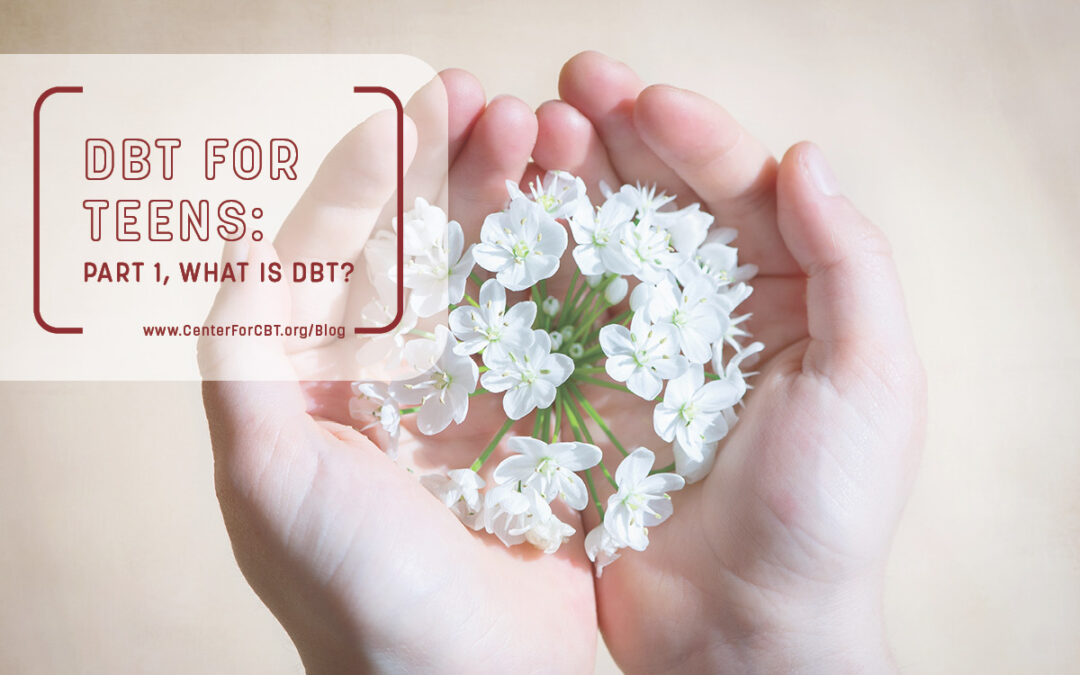Therapy, which has long been a sensitive subject, is becoming more commonplace as the much-needed dialogue surrounding it increases. There are a variety of treatments that can help address a range of challenges, some of which you may already be familiar with. You may have heard of dialectical behavior therapy (DBT) through a provider who recommended it for your teen. Or maybe you caught word of it from celebrities such as Lady Gaga and Selena Gomez, whose public openness about their experience with DBT helps normalize discussions of therapy. Even if you’ve heard of DBT, you may be searching for answers about what it is, what it helps with, and how it works. We’re here to help you navigate the ins-and-outs of the treatment approach and key components to help you understand how DBT might be helpful for you and your teen.
What is DBT?
DBT is a therapy for individuals who have difficulty managing their emotions and behaviors. This may mean that they feel emotions more intensely than other people, making them difficult to tolerate. As a result, individuals might attempt to cope with painful emotions by engaging in harmful behaviors such as self-injury, substance abuse, or unhealthy eating. A renowned treatment for managing emotions and behavior, DBT helps people experience and regulate their emotions without necessarily acting on them. As an evidence-based treatment, it has been shown through research to be an effective approach in treating numerous difficulties. Initially developed by Dr. Marsha Linehan for adults with borderline personality disorder, the method has also been adapted to treat adolescents and pre-teen children with severe trouble managing their emotions.
DBT was developed as an alternative treatment for challenges that were not successfully addressed by cognitive behavioral therapy (CBT) alone. DBT draws heavily from such behavioral treatments and is tailored to treat the more complex concerns of self-harm and emotion dysregulation. DBT shares a similar goal in helping people understand the connections between their thoughts, feelings, emotions and behaviors, and how changing adverse patterns of thought and behavior can improve how they feel.
Additionally, DBT draws deep roots from eastern religions and philosophies with concepts such as dialectics, a key element of DBT. A dialectic is the idea that two seemingly opposing ideas can both be true. DBT balances the dialectic of acceptance and change — two things that at face value seem to be the opposites, though when practiced together, can enable individuals to improve their lives. Therapists work to help teens learn to tolerate distress, validate emotions and accept things as they are, while also working to help teens change patterns of thoughts, emotions and behaviors which may contribute to challenges such as depression, self-harm, and suicidal thinking. These concepts are an integral part of each component in a comprehensive DBT program, and emphasized throughout treatment.
What Challenges Does DBT for Teens Address?
The overarching goal of DBT is to help adolescents build a life worth living. Teens struggling with depression, significant family conflict, or difficulties regulating emotions may at times feel that their life is not worth living as it is, especially if these problems have been persistent. Adolescent DBT aims to address five main “problem areas” so that teens can identify short-term and long-term goals to build a life they want to live.
- Confusion of the self: Being unaware of one’s own emotions, not understanding thoughts and urges, or being unsure of why one feels or acts in certain ways. This may manifest as feeling stuck in the past or worrying about the future, both of which are patterns of thought that make it difficult to focus on and be present in the moment. Teens may also feel confusion about what their individual goals and values are.
- Emotion Dysregulation: Dysregulation occurs when one feels emotions intensely and has little control over managing them and/or resulting behavior. This can look like fast, intense mood changes or a long-lasting negative emotional state, such as depression.
- Impulsivity: This can be acting on an emotion or urge without evaluating the possible outcomes or consequences. Impulsive actions can include substance use, self-harm, impulsive eating, and verbal or physical outbursts fueled by anger. These behaviors may be engaged in to avoid or escape painful emotional experiences.
- Interpersonal Problems: This pertains to one’s relationships with other people, including peers. Interpersonal challenges may result in difficulty maintaining healthy relationships, lots of conflict in relationships, and potential loneliness due to the way relationships have been adversely affected. Maintaining self-respect in the face of peer pressure, as well as voicing one’s own needs and saying no to others are also challenges teens may face.
- Teen and Family Challenges: While conflicts between teens and their parents or other family members may be the norm, significant conflict can be an area of concern. Challenges commonly faced include difficulty understanding each other’s emotions, actions, or point of view, as well as parents and teens being “polarized” or being on extremes in terms of the way they think and act.
Being presented with a long list of difficulties may seem overwhelming at first. The good news is that DBT offers a set of skills for each “problem area” to help individuals and families cope with these challenges. DBT skills teach how to address adverse patterns of thoughts and behaviors by replacing them with more skillful ways of thinking and acting and how to tolerate difficult emotions. Building a life worth living is a step-by-step process that takes both practice and patience.
In our upcoming article, we will be explaining the main components of comprehensive DBT treatment, as well as the skill sets taught to help address “problem areas” in a teen’s life. Please join us next week when we cover the details of what these skills entail, and how they can be used.


